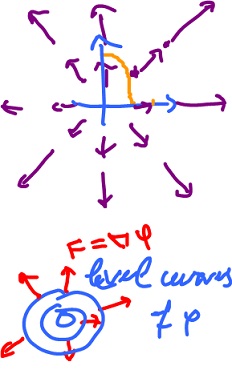This site is being phased out.
Independence of path
When does the work integral along curve $C$
$$\displaystyle\int_C F dV$$
depend only on the initial and final points of $C$?
Example. Suppose $C$ is a closed curve on the plane. Since the initial point is equal to the final point of $C$, if the integral is path independent, we have
$$\displaystyle\int_C F dV = 0.$$
Now, by the Jordan Theorem, it follows that $C$ bounds a region $R$. Then by the Stokes Theorem,
$$0 = \displaystyle\int_{C= \partial R} F dV = \displaystyle\int\displaystyle\int_R 1 dA.$$
This certainly wouldn't work for all possible $F$. For example, if
$$F = ( 0, x ),$$
then
Example. Suppose $F$ is the force field of gravity:
$$F = ( 0, g_m ),$$
where $g_m$ is the gravitational constant. Let us determine if it is path independent:
$$\displaystyle\int_C F dV = \displaystyle\int_a^b ( 0, g_m ) p'(t) dt$$
with the parametrization $p(t), t \in [ a, b ]$. The above is equal to
$$\begin{array}{} \displaystyle\int_a^b g_m p'_2(t) dt &= g_m \displaystyle\int_a^b p'_2(t) dt \\ &= g_m ( p_2(b) - p_2(a) ) \end{array}$$
with the Fundamental Theorem of Calculus. Now
$$g_m ( p_2(b) - p_2(a) ) = g_m ( B_2 - A_2 ),$$
where $A$ and $B$ are the end points of $C$. So, the answer is Yes.
The same holds for any other constant force $F$.
If the work is independent of path, the force is called conservative.
It is sufficient for the force to have a potential function:
Theorem. If $F$ has a potential function, then it is conservative:
i.e.
$$\displaystyle\int_{C_1} F dV = \displaystyle\int_{C_2} F dV$$
for all piecewise-smooth curves $C_1, C_2$ with the same end points.
Proof. Simply compute the line integral for a specific parametrization] $p$ of $C$:
$$\begin{array}{} \displaystyle\int_C F dV &= \displaystyle\int_a^b F( p(t) ) p'(t) dt \\ &= \displaystyle\int_a^b ∇ {\varphi}( p(t) ) p'(t) dt {\rm \hspace{3pt} (right-hand \hspace{3pt} side \hspace{3pt} of \hspace{3pt} chain \hspace{3pt} rule)} \\ &= \displaystyle\int_a^b d / dt {\varphi}( p(t) ) dt \\ &= {\varphi}( p(b) ) - {\varphi}( p(a) ) {\rm \hspace{3pt} (Fundamental \hspace{3pt} Theorem \hspace{3pt} of \hspace{3pt} Calculus)} \\ &= {\varphi}( A ) - {\varphi}( B ), \end{array}$$
where $A$ and $B$ are the end points of $C$. QED
Corollary. If
$$F = \nabla {\varphi}$$
under the conditions of the above theorem, then
$$\displaystyle\int_C F dV = {\varphi}( B ) - {\varphi}( A ).$$
Example. Let $F( x, y ) = ( x, y )$, and $C$ the image of $( {\rm cos \hspace{3pt}} t, 2 {\rm sin \hspace{3pt}} t )$ for $t \in [ 0, \frac{\pi}{2} ]$.
Then find ${\varphi}$ satisfying:
$$\nabla {\varphi} = ( x, y ).$$
Then
$$\frac{{\partial}{\varphi}}{\partial x} = x, \frac{d{\varphi}}{dy} = y.$$
Hence
$${\varphi}( x, y ) = \displaystyle\int x dx = \frac{x^2}{2} + C(y),$$
$${\varphi}( x, y ) = \displaystyle\int y dy = \frac{y^2}{2} + D(x),$$
thus together we obtain
$${\varphi}( x, y ) = \frac{x^2}{2} + \frac{y^2}{2}.$$
Now
$$\begin{array}{} \displaystyle\int_C F dV &= {\varphi}( {\rm end \hspace{3pt} point} ) - {\varphi}( {\rm initial \hspace{3pt} point} ) \\ &= {\varphi}( {\rm cos \hspace{3pt}} \frac{\pi}{2}, 2 {\rm sin \hspace{3pt}} \frac{\pi}{2} ) - {\varphi}( {\rm cos \hspace{3pt}} 0, 2 {\rm sin \hspace{3pt}} 0 ) \\ &= {\varphi}( 0, 2 ) - {\varphi}( 1, 0 ) \\ &= \frac{2^2}{2} - \frac{1^2}{2} \\ &= \frac{3}{2}. \end{array}$$
Example. Let $F( x, y ) = ( e^y, x e^y )$. Then
$$\frac{{\partial}{\varphi}}{\partial x} = e^y, \frac{d{\varphi}}{dy} = x e^y,$$
hence
$${\varphi}( x, y ) = x e^y + C(y),$$
$${\varphi}( x, y ) = x e^y + D(x).$$
Combining, we obtain
$${\varphi}( x, y ) = x e^y.$$
Example. Let $F = ( 0, x ).$ To find ${\varphi}$, solve
$$\frac{{\partial}{\varphi}}{\partial x} = 0, \frac{d{\varphi}}{dy} = x,$$
then
$${\varphi} = C(y) = {\varphi} = xy + D(x).$$
Here the left-hand side depends only on $x$ and the right-hand side depends only on $y$. This is impossible. So, this force does no have a potential function.
Theorem. Suppose $F = ( F_1, ..., F_n )$ has continuous partial derivatives on an open ball $R$. If
$$\frac{{\partial}F_i}{{\partial}x_j} = \frac{{\partial}F_j}{{\partial}x_i},$$
then $F$ is conservative.
Note: here "open ball" can be replaced with "simply connected open set". The difference is whether you can get from $A$ to $B$ in two (topologically) different ways.
Example. Consider $F = ( F_1, F_2 ) = ( 0, x )$, then
$$\frac{{\partial}F_1}{{\partial}x_2} = 0 \neq \frac{{\partial}F_2}{{\partial}x_1} = 1.$$
Theorem. Assume $R$ is path connected, $F$ has continuous partial derivatives and $C$ is piecewise smooth. Then the following are equivalent:
- $\displaystyle\int_C F dV$ is path independent,
- $F = \nabla {\varphi}$,
- $\displaystyle\int_C F dV = 0$, and $C$ is a closed curve.
Proof. $(1) \rightarrow (2)$. Define
$${\varphi}(x) = \displaystyle\int_C F dV,$$
where $C$ is a curve from a fixed point $x_0$ to $x$. Note that $F$ is integrable on any $[ a, x ] \subset [ a, b ]$. Then define
$$F(x) = \displaystyle\int_a^x f(x) dx.$$

